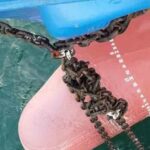Real Life Incident: Fire On Board With Unclear Extinguishing System
A car/truck carrier, loaded with new and used vehicles, was underway at sea when the fire alarm sounded in the cargo compartment on deck 1 (the lowest deck). Following this, fire detectors on other decks also sounded.
The crew mustered and a team was sent to investigate. Personnel on the bridge tried to assess the situation using a surveillance camera on deck 4, but nothing out of the ordinary could be observed.
The search team reported that thick black smoke could be seen further astern on deck 1. No MAYDAY or PAN-PAN call was made and nearby vessels were not contacted.

It was decided to use the CO2 fire suppression system to combat the fire. Once it was confirmed that all crew were accounted for, the chief engineer initiated the extinguishing system. However, because there were two different versions of the activation procedure posted – one from the manufacturer, one from the ship – he found the instructions unclear. After about five minutes, he was finally able to activate the system, some 26 minutes since the fire alarm had first sounded.
Soon afterward, smoke was seen coming out of one of the ventilators on the upper deck. The ventilator’s fire dampers should have closed automatically when the fire alarm or the fire suppression system was activated, but one damper remained open. It was quickly closed manually. An inspection the following day revealed that the fire had been extinguished but had caused major structural damage.
The investigation found that the origin of the fire was probably due to a short circuit in the starting motor of one of the cars. The high temperature caused by the short circuit melted a copper plate in the starting motor solenoid, which began the fire sequence.
Lessons learned
- Are there confusing, contradictory or competing procedures for CO2 activation (or other actions) on your ship? Correct the situation before an incident occurs.
- Calling for help (PAN-PAN or distress message) is always a good idea when a fire breaks out. If it is brought under control you can always cancel the message.
- Always ensure all crew is accounted for before CO2 is activated.
- Always check before and after CO2 activation that all ventilation to space is well and truly closed.
Reference: nautinst.org
Do you have info to share with us ? Suggest a correction
About Author
Marine Insight News Network is a premier source for up-to-date, comprehensive, and insightful coverage of the maritime industry. Dedicated to offering the latest news, trends, and analyses in shipping, marine technology, regulations, and global maritime affairs, Marine Insight News Network prides itself on delivering accurate, engaging, and relevant information.

About Author
Marine Insight News Network is a premier source for up-to-date, comprehensive, and insightful coverage of the maritime industry. Dedicated to offering the latest news, trends, and analyses in shipping, marine technology, regulations, and global maritime affairs, Marine Insight News Network prides itself on delivering accurate, engaging, and relevant information.
- Real Life Incident: Vessel Collision in Good Visibility
- Real Life Incident: Severe Injury To Deck Crew While Leaving Berth
- Real Life Incident: Departure Damage in Very Restricted Waterway
- Real Life Incident: Low Situational Awareness Has High Impact Consequence
- Real Life Incident: Fouled Anchor in a Designated Anchorage
- Real Life Incident: Fire On Barge Carrying Scrap Metal Causes $7 Million Worth Of Damage
Latest Case studies Articles You Would Like:
Subscribe To Our Newsletters
By subscribing, you agree to our Privacy Policy and may receive occasional deal communications; you can unsubscribe anytime.















